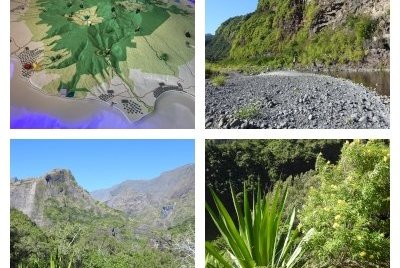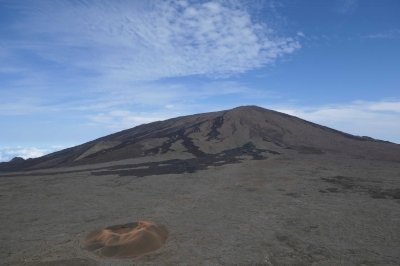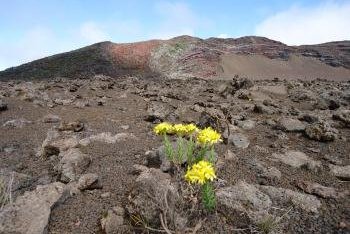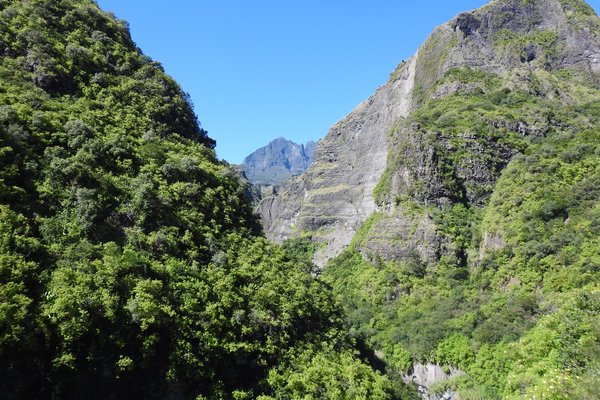France
Pitons of Reunion
The 'Pitons, cirques and remparts' of Reunion Island are renowned for their visually striking landscape and remaining high numbers of endemic plant species.
The site consists of two adjoining volcanic massifs, with remparts (steep rock walls) and the three cirques (imposing natural amphitheaters) of Salazie, Mafate et Cilaos that evolved due to erosion and volcanism. The Pitons are covered with subtropical rainforests and cloud forests.
Community Perspective: Kbecq has described the four tough hikes he did here on volcanic terrain, while Els hiked into the Cirque de Mafate.
Site Info
Official Information
- Full Name
- Pitons, cirques and remparts of Reunion Island (ID: 1317)
- Country
- France
- Status
-
Inscribed 2010
Site history
History of Pitons of Reunion
- 2010: Inscribed
- Inscribed
- 2009: Postponed
- "This decision was required due to the fact that three nominations from France were proposed for consideration by the 33rd Session of the World Heritage Committee. The State Party of France had been requested by the UNESCO World Heritage Centre to identify two nominations in line with the limits on annual numbers of nominations set in the Operational Guidelines." (AB ev)
- Type
- Natural
- Criteria
- vii
- x
Links
- UNESCO
- whc.unesco.org
- Official
-
- reunion-parcnational.fr — Parc national de La Réunion
All Links
UNESCO.org
- whc.unesco.org — whc.unesco.org/
Official Website
- reunion-parcnational.fr — Parc national de La Réunion
News Article
- Aug. 2, 2015 theguardian.com — Piton de la Fournaise volcano erupts on island of Reunion
- Oct. 31, 2011 expatica.com — Wildfire threatens Reunion Island NP
Community Information
- Community Category
- Natural landscape: Volcanic
Travel Information
Recent Connections
-
Centres of Plant Diversity
IO2 Mascarene Islands - "The property i… -
Located in a TCC Territory
Reunion -
Virgin Forests
Réserve biologique intégrale du Piton d…
Connections of Pitons of Reunion
- Geography
-
-
Indian Ocean
-
Canyons
-
Recently Active Volcanoes
Piton de la Fournaise, one of the most active in the world, recently in January 2010See en.wikipedia.org
-
Volcanic Cone
Formica Leo -
Cirques
The peak of the Piton des Neiges lies at the centre of three such scarp-rimmed 'cirques' of Salazie, Mafate, Cilaos and the infilled 'palaeocirque' of Bébour (AB ev) -
World's Highest Topographically isolated summits
Piton de Neiges 14th most isolated (2766/3071)
-
- Ecology
-
-
Volcanic Hotspots
Reunion HotspotSee en.wikipedia.org
-
Rainforests
Subtropical rainforests -
Virgin Forests
Réserve biologique intégrale du Piton de la FournaiseSee en.wikipedia.org
-
Critically endangered fauna species
Reunion Cuckooshrike (66 remaining) -
Endemic Bird Species
Réunion EBA, Piton des Neiges - Gros Morne: Olivaceous Bulbul (Hypsipetes borbonicus), Mascarene Grey White-eye (Zosterops borbonicus), Reunion Olive White-eye (Zosterops olivaceus), Reunion Stonechat (Saxicola tectes)See www.birdlife.org
-
Cloud forest
-
Turtles and tortoises
hawksbill turtle, green turtle
-
- World Heritage Process
-
-
WHS with enclave
See map. Three enclaves.
-
- Human Activity
-
-
Maroonage
... from 1807 with sugar plantations for which labor came from Africa, Madagascar, India, Malaya and China, soon relegated to the status of slaves. The Cirque de Cilaos was cultivated for nearly 100 years by escaped slaves known as marrons whose leaders names are commemorated in the landscape of the cirques (UNEP-WCMC)
-
- WHS on Other Lists
-
-
Located in a TCC Territory
Reunion -
Centres of Plant Diversity
IO2 Mascarene Islands - "The property is a global centre of plant diversity with a high degree of endemism. It contains the most significant remaining natural habitats for the conservation of the terrestrial biodiversity of the Mascarene Islands, including a range of rare forest types. " -
Biodiversity hotspot
Madagascar and the Indian Ocean Islands
-
- Timeline
-
-
Holocene
Le piton de la Fournaise, comme on le connaït aujourd'hui, date d'environ 4 700 ans. Cet âge correspond à l'effondrement majeur qui a donné naissance à l'enclos Fouqué en s'accompagnant d'explosions cataclysmiques. (Wiki)
-
News
- theguardian.com 08/02/2015
- Piton de la Fournaise volcano erup…
- expatica.com 10/31/2011
- Wildfire threatens Reunion Island …
Recent Visitors
Visitors of Pitons of Reunion
- Adrian Turtschi
- alex
- Alexander Lehmann
- alicemears
- A. Mehmet Haksever
- Artur Anuszewski
- Aunti
- AustralLights
- Bill Maurmann
- Bram de Bruin
- Delphine Delaunay
- Dorejd
- Els Slots
- Eva Kisgyorgy
- Geert Luiken
- George Gdanski
- giloudepuertorico
- Gjert
- HaraldOest
- Harry Mitsidis
- Iain Jackson
- Ivan Rucek
- janameerman
- Janos
- Jarek Pokrzywnicki
- Jay T
- KarenBMoore
- Kbecq
- Kevin McFarland
- Laurine
- Loic Pedras
- Luis Filipe Gaspar
- Mahuhe
- Marinemajor
- Martina Rúčková
- MaxHeAnouBen
- Michael Ayers
- Michael Novins
- Morodhi
- Naim Y
- Patrik_globe
- Potsdamer
- Randi Thomsen
- Roger Ourset
- Roman Bruehwiler
- Samy G
- Sandra!
- Slavi
- Svein Elias
- Thomas Buechler
- Vernon Prieto
- WalGra
- Weecheng
- WILLIAM RICH
- Zoë Sheng
Community Reviews
Show full reviews
‘Completing’ France is a tough act, as its WHS include sites in four overseas territories scattered across the globe. The French Austral Lands are the hardest (9,000 EUR/28 days if you’re lucky to get a spot). Somewhat near in the Indian Ocean but much more accessible is Réunion, served by daily direct flights from Paris. This island is governed as an overseas department and its culture is very, very French. Réunion is blessed with its own WHS, the Pitons, Cirques and Remparts.
The WHS area geographically is a bit complicated, although it would be hard to never set foot in the core zone while spending a few days on the island. Generally, it covers the whole interior, but, it’s a WHS with an enclave, three enclaves even: they are the villages inside the cirques. And, the WHS is slightly larger than the national park. La Maison du Parc in La Plain des Palmistes, which acts as the park’s visitor center, has a very clear scale model of the island depicting the park’s borders and the WHS extras. I discovered the WHS plaque there as well: it is situated in a flowerbed to the right, about 10m before you enter the building. This WHS overall scores very well on the scale of the WHS commandments, with the wonderful bespoke plaque, the scale model showing core and buffer zones, and the park also being free to enter.
For my deep dive into the park, I choose the Cirque …
Keep reading 0 comments
Contrary to its neighbour Mauritius, Réunion island does not have a lot of beaches so most people (including ourselves) come for hiking.
Over the course of four days we did four hikes: (i) Trou de Fer, (ii) Col du Taïbit/Marla, (iii) Piton des Neiges, and (iv) Piton de la Fournaise. These and more hikes can be found on the website https://en.reunion.fr/organize/hiking-trails where also GPX tracks can be downloaded and practical information is provided (where to park, distances, …). However, we didn’t need GPX tracks since all hikes are well marked.
Whatever hike you do, it is recommended to do it before noon since later in the day the clouds come in limiting visibility and consequently blocking the nice view you hoped to have after climbing for a couple of hours.
Below some comments per hike we did (end of September):
Trou de Fer: large car park at the Gîte de Bélouve / start of the hike. In principle, this is a easy walk but the day(s) before we arrived it rained and during our walk it started raining again making the trail very very (ankle deep) muddy. We even considered turning back but in the end made it to the viewpoint which was worth the hassle.
Col du Taïbit: only a couple of parking spaces at the start of the route so start early (but alternatively there is a bus stop). The route goes up to the Col du Taïbit and back down to the …
Keep reading 0 comments
Non argueably one of world's wonders. Tropical forests, cirques, volcano, steep mountains, canyoons, watarfalls, everything can be found there.
Reunion National Park covers relatively big area almost entire interior (except those around villages), easy accesible by foot (marked trails) or bus. For those with limited time the best starting point to see the cirques is either Cilaos or Salazie (both accessible by bus).
For visiting the volcano (Piton de la Fournaise) it is better to have your own / rent car good road from Bourg-Murat up to Pas de Bellecombe (free parking). Otherwise it is a half day walk up to Gite de volcano. Piton de la Fournaise resembles Teide of Tenerife but at least the crater area is much, much bigger.
Keep reading 0 comments
